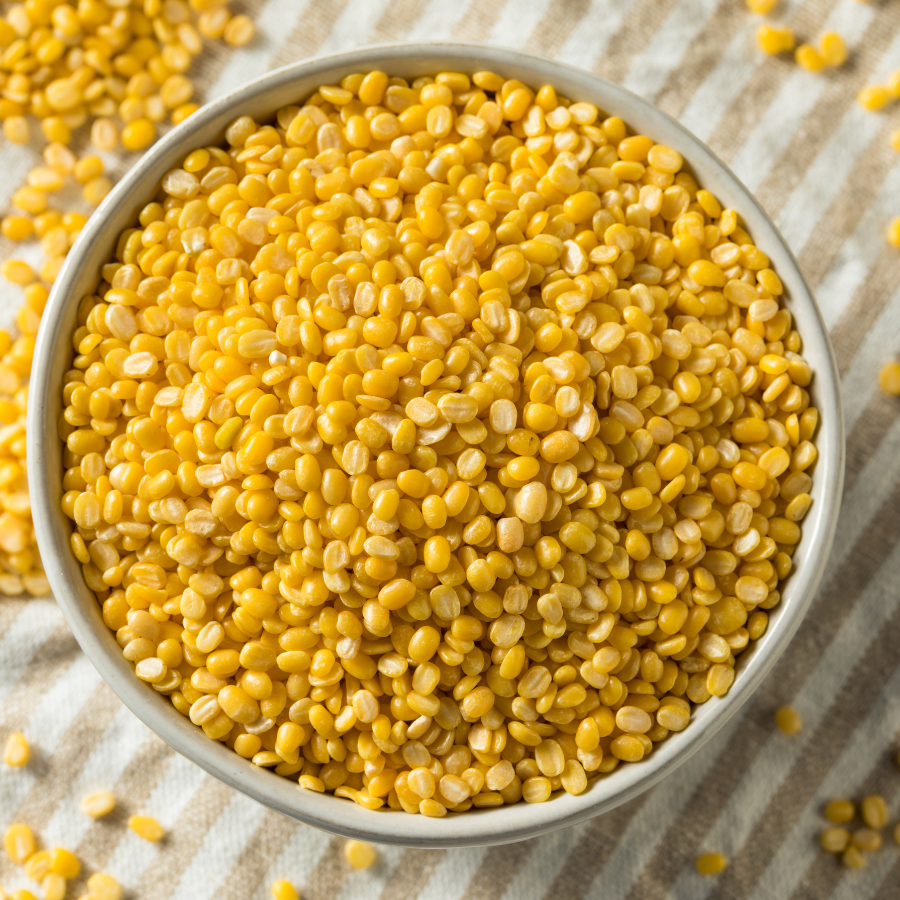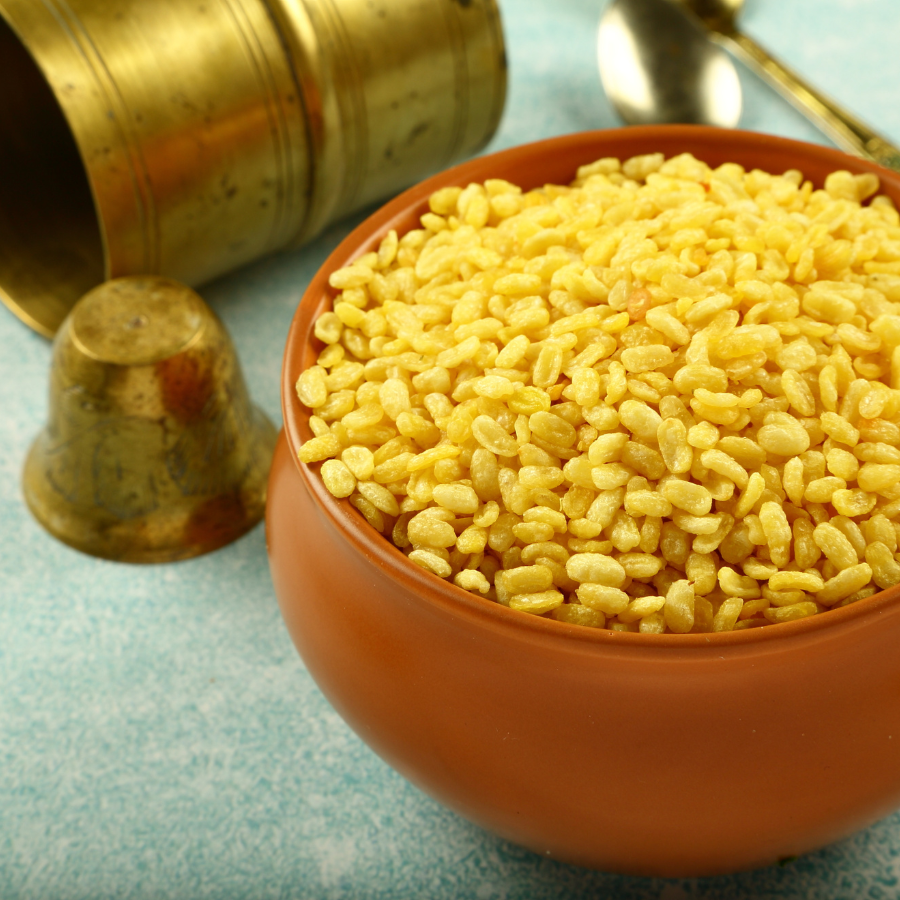Vigna radiata (Yellow Lentil, Moong Dal) Seeds
Vigna radiata, commonly known as Yellow Lentil or Moong Dal, is a small-seeded legume prized for its mild, nutty flavor, quick cooking time, and exceptional nutritional benefits. A staple in Indian, Southeast Asian, and Middle Eastern cuisines, Moong Dal is used in soups, dals, salads, and desserts. This versatile crop is known for its adaptability, high yield, and nitrogen-fixing ability, making it a valuable addition to home gardens and sustainable farming systems.
Characteristics
Moong Dal plants are bushy, growing up to 30–60 cm in height. The plants produce trifoliate green leaves and small yellow flowers that develop into slender pods containing small, round seeds. When split and hulled, the seeds reveal a bright yellow interior, which is the commonly recognized Moong Dal. Known for its creamy texture and delicate flavor, it is easy to digest and suitable for a wide range of dishes.
Uses and Benefits
Moong Dal is a cornerstone of many Indian dishes, such as dal tadka, soups, and khichdi. It is also used in salads, pancakes, and desserts like halwa. Rich in protein, dietary fiber, folate, and essential minerals like magnesium and potassium, Moong Dal supports heart health, improves digestion, and provides sustained energy. Its low glycemic index makes it a diabetic-friendly food, and it is ideal for weight management diets.
Cultivation
Moong Dal thrives in warm, tropical, and subtropical climates, preferring well-drained sandy or loamy soils with a pH of 6.0–7.5. Prepare the soil by incorporating organic compost or manure before planting. Sow seeds at a depth of 2–3 cm, spaced 10–15 cm apart in rows 30–45 cm apart. Germination occurs within 5–7 days under optimal conditions. The plants require full sun and moderate watering, particularly during flowering and pod formation. Moong Dal matures quickly, typically in 60–70 days, making it an ideal choice for short growing seasons. Pods can be harvested when green for fresh use or allowed to mature and dry for storing lentils.
Unique Features
Yellow Lentils are easy to cook, requiring no soaking. They break down into a smooth, creamy consistency, making them ideal for soups, dals, and purees. As a nitrogen-fixing crop, Moong Dal improves soil fertility, supporting sustainable farming practices.
Growing Tips
Plant in well-drained soil and avoid waterlogging, as excess moisture can harm the roots. Rotate crops annually to enhance soil health and minimize pests. Harvest pods regularly to encourage continuous production and ensure high-quality lentils.
Shipping
Available for shipping within India and worldwide. Orders are typically dispatched within 1–2 weeks.
From Deodar Seeds Company.
Vigna radiata, commonly known as Yellow Lentil or Moong Dal, is a small-seeded legume prized for its mild, nutty flavor, quick cooking time, and exceptional nutritional benefits. A staple in Indian, Southeast Asian, and Middle Eastern cuisines, Moong Dal is used in soups, dals, salads, and desserts. This versatile crop is known for its adaptability, high yield, and nitrogen-fixing ability, making it a valuable addition to home gardens and sustainable farming systems.
Characteristics
Moong Dal plants are bushy, growing up to 30–60 cm in height. The plants produce trifoliate green leaves and small yellow flowers that develop into slender pods containing small, round seeds. When split and hulled, the seeds reveal a bright yellow interior, which is the commonly recognized Moong Dal. Known for its creamy texture and delicate flavor, it is easy to digest and suitable for a wide range of dishes.
Uses and Benefits
Moong Dal is a cornerstone of many Indian dishes, such as dal tadka, soups, and khichdi. It is also used in salads, pancakes, and desserts like halwa. Rich in protein, dietary fiber, folate, and essential minerals like magnesium and potassium, Moong Dal supports heart health, improves digestion, and provides sustained energy. Its low glycemic index makes it a diabetic-friendly food, and it is ideal for weight management diets.
Cultivation
Moong Dal thrives in warm, tropical, and subtropical climates, preferring well-drained sandy or loamy soils with a pH of 6.0–7.5. Prepare the soil by incorporating organic compost or manure before planting. Sow seeds at a depth of 2–3 cm, spaced 10–15 cm apart in rows 30–45 cm apart. Germination occurs within 5–7 days under optimal conditions. The plants require full sun and moderate watering, particularly during flowering and pod formation. Moong Dal matures quickly, typically in 60–70 days, making it an ideal choice for short growing seasons. Pods can be harvested when green for fresh use or allowed to mature and dry for storing lentils.
Unique Features
Yellow Lentils are easy to cook, requiring no soaking. They break down into a smooth, creamy consistency, making them ideal for soups, dals, and purees. As a nitrogen-fixing crop, Moong Dal improves soil fertility, supporting sustainable farming practices.
Growing Tips
Plant in well-drained soil and avoid waterlogging, as excess moisture can harm the roots. Rotate crops annually to enhance soil health and minimize pests. Harvest pods regularly to encourage continuous production and ensure high-quality lentils.
Shipping
Available for shipping within India and worldwide. Orders are typically dispatched within 1–2 weeks.
From Deodar Seeds Company.
Yellow Lentil (Moong Dal) seeds - 100
- Brand: Deodar Seeds
- Product Code: LEG35.1
- Availability: In Stock
₹438.00










